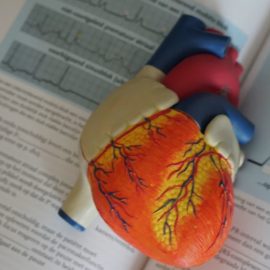

This article is an excerpt from the Shortform book guide to "How Not to Die" by Michael Greger. Shortform has the world's best summaries and analyses of books you should be reading.
Like this article? Sign up for a free trial here .
What are the three different types of digestive cancer? Is there anything you can do to prevent developing digestive cancer?
On average, digestive cancer causes 114,000 deaths every year. This includes: colorectal cancer (50,000), 2) pancreatic cancer (46,000), and 3) esophageal cancer (18,000). Luckily, there are a few measures you can take to reduce your risk of contracting digestive cancer.
Keep reading to learn more about digestive cancers, their main risk factors, survival rates, and prevention.
The Digestive System
The digestive system has a surface area of thousands of square feet, much more than the 20 square feet of skin and hundreds of square feet of lungs. Consider your digestive tract the interface with the world.
Colorectal Cancer Prevention
Colorectal cancer is among the most treatable of the digestive cancers—if diagnosed before it spreads the colon, the 5-year survival rate is 90%.
- Starting at age 50 to 75, get stool testing every year, or stool testing every 3 years plus sigmoidoscopy every 5 years, or a colonoscopy every 10 years.
Have larger stool size during bowel movements.
- Larger stools and faster intestinal transit time are associated with lower rates of colon cancer.
- A good stool weight is half a pound. People with quarter pound stools have 3x the rate of colon cancer.
- The larger the stool, the faster the transit time. A good time is 24-36 hours. This can be tested by eating beets, then noticing when your stool turns pink.
- Constipation can be solved with dietary fiber.
Phytates
- Found in seeds, grains, beans, and nuts.
- Phytates have a host of good health properties: they’re antioxidant, anti-inflammatory, anti-angiogenic, and immune-enhancing (by activating natural killer cells).
- In lab studies, phytates also inhibit the growth of human cancer while leaving human cells alone.
- Phytates remove excess iron, which can generate hydroxyl radicals.
- Meat eaters absorb high amounts of heme iron, which is often not counterbalanced by eating more seeds and nuts.
- Phytates were once feared to inhibit mineral absorption, but later studies showed that people eating high levels of phytates tend to have greater bone mineral density and fewer hip fractures.
- High vegetable, low-meat diets have 8x risk of colorectal cancer compared to low-vegetable, high-meat diets.
- Increasing bean consumption by ¼ cup a day cuts polyp recurrence by 65%.
Berries
- Berries contain antioxidants, which suppress cancer cell growth in vitro.
- Eating black raspberries cut the polyp count of patients with familial adenomatous polyposis in half.
Turmeric
- Contains curcumin, which has antioxidant and anti-mutagenic properties. Curcumin doesn’t get absorbed well into the bloodstream, but it stays intact in the digestive tract to interact with polyps.
- In a study, curcumin reduced the occurrence and size of polyps throughout the spectrum of colorectal cancer, from aberrant foci to benign polyps to cancerous polyps, by up to 40%.
- Cancer rates in India are much lower than those in the United States—for example, the US shows 10 times more colorectal cancer, 12x more kidney cancer. Turmeric may explain part of it, but another contributor may be less meat-eating: only 7% of Indians eat meat on a daily basis, with most of their diet consisting of leafy vegetables and legumes.
Red meat problems
- Eating processed and unprocessed red meat is associated with increased mortality from cancer and heart disease, and lower lifespans—even after controlling for age, weight, alcohol, exercise, smoking, family history, and intake of plant foods. This suggests there is something bad about eating meat itself.
- It could be heme-iron—iron is a pro-oxidant (the opposite of an antioxidant) that generates free radicals. The heme-iron in meat is also absorbed more effectively by the digestive tract compared to non-heme iron from plants, and heme-iron also has less autoregulation of absorption to prevent you from absorbing too much. In short, if you have too much iron in your body, you stop absorbing non-heme iron from plant foods, but you keep absorbing heme iron from meat.
- Good plant sources of iron include whole grains, legumes, nuts, seeds, dried fruits, and green leafy vegetables.
- Vitamin C helps with iron absorption.
Pancreatic Cancer Prevention
Pancreatic cancer is one of the deadliest cancers because of late detection. Only 6% of patients survive 5 years after being diagnosed with pancreatic cancer, compared to 90% for colorectal cancer.
Risk factors for pancreatic cancer include smoking, obesity, and alcohol.
Avoid animal fat.
- Fat from animal sources is associated with pancreatic cancer risk. No correlation was found with plant fats.
Avoid chicken.
- Workers who slaughter chickens have 9 times the odds of pancreatic and liver cancer. In comparison, smoking only doubles the odds of pancreatic cancer.
- For every 50g of chicken consumed daily, you increase your risk of pancreatic cancer by 72%.
- The cause is not currently clear. One suspect is chicken cancer viruses that cause warts.
Eat more turmeric.
- For pancreatic cancer patients, 2 out of 21 responded to treatment with turmeric. One patient had a 73% reduction in tumor size until a curcumin-resistant tumor appeared. Another showed improvement over 18 months.
- While these numbers sound low, a similar % of patients responded to chemotherapy.
Esophageal Cancer Prevention
Esophageal cancer has a 5-year survival rate of <20%. Risk factors for esophageal cancer are smoking, alcohol, and acid reflux (heartburn).
Reduce acid reflux through diet.
- Over the past 30 years, esophageal cancer has increased 6-fold. This is possibly due to better detection of the disease, but also possibly due to an increase in acid reflux.
- 28% of people in the US suffer weekly heartburn, compared to 5% in Asia.
- Meat and high-fat meals are associated with acid reflux, followed by cancer in the esophagus. This could be because the hormone cholecystokinin is triggered by meat and eggs, and this may relax the esophageal sphincter, causing stomach acid to spill into the stomach.
- Meat-eaters have 2x the odds of reflux-induced esophageal inflammation, compared to vegetarians.
Fiber
- High fiber intake reduces the incidence of esophageal cancer by ⅓.
- Low-fiber diets cause straining while passing stool. This increases abdominal pressure and can push the stomach out of the abdomen, which leads to acid reflux. High abdominal pressure also causes hemorrhoids and diverticulosis.
Strawberries
- Eating 1-2 ounces of freeze-dried strawberries everyday for 6 months caused reversal of disease in 80% of patients with precancerous esophageal lesions.

———End of Preview———
Like what you just read? Read the rest of the world's best book summary and analysis of Michael Greger's "How Not to Die" at Shortform .
Here's what you'll find in our full How Not to Die summary :
- The health benefits of a plant-based, whole-food diet
- How to reduce your risk of developing the most common diseases that can kill you
- The 12 foods you should eat daily to maximize health benefits






